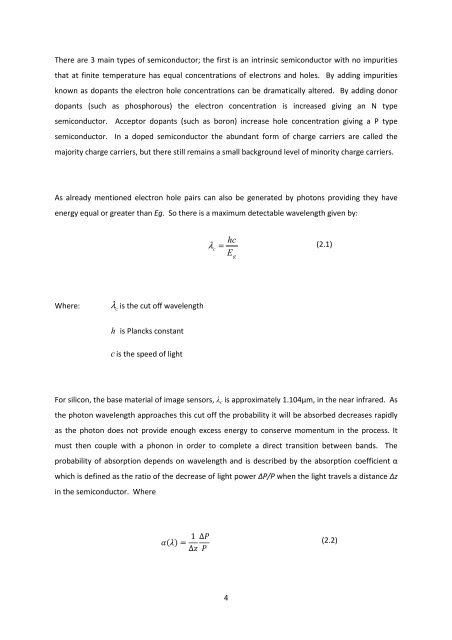Dissertation - FTP Directory Listing - University of Surrey
Dissertation - FTP Directory Listing - University of Surrey
Dissertation - FTP Directory Listing - University of Surrey
Create successful ePaper yourself
Turn your PDF publications into a flip-book with our unique Google optimized e-Paper software.
There are 3 main types <strong>of</strong> semiconductor; the first is an intrinsic semiconductor with no impuritiesthat at finite temperature has equal concentrations <strong>of</strong> electrons and holes. By adding impuritiesknown as dopants the electron hole concentrations can be dramatically altered. By adding donordopants (such as phosphorous) the electron concentration is increased giving an N typesemiconductor. Acceptor dopants (such as boron) increase hole concentration giving a P typesemiconductor. In a doped semiconductor the abundant form <strong>of</strong> charge carriers are called themajority charge carriers, but there still remains a small background level <strong>of</strong> minority charge carriers.As already mentioned electron hole pairs can also be generated by photons providing they haveenergy equal or greater than Eg. So there is a maximum detectable wavelength given by:hcλc=(2.1)EgWhere:λcis the cut <strong>of</strong>f wavelengthh is Plancks constantc is the speed <strong>of</strong> lightFor silicon, the base material <strong>of</strong> image sensors, λ c is approximately 1.104µm, in the near infrared. Asthe photon wavelength approaches this cut <strong>of</strong>f the probability it will be absorbed decreases rapidlyas the photon does not provide enough excess energy to conserve momentum in the process. Itmust then couple with a phonon in order to complete a direct transition between bands. Theprobability <strong>of</strong> absorption depends on wavelength and is described by the absorption coefficient αwhich is defined as the ratio <strong>of</strong> the decrease <strong>of</strong> light power ΔP/P when the light travels a distance Δzin the semiconductor. Where = 1 ∆∆ (2.2)4
















